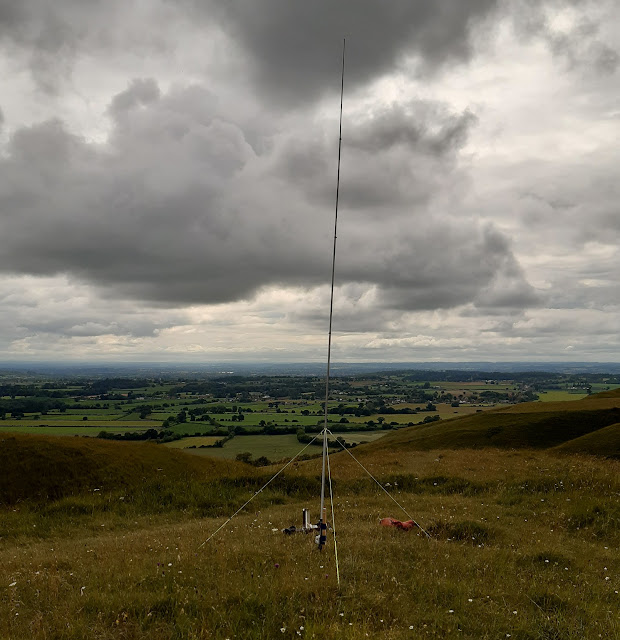A few years ago I was given some old CB radio equipment, including a base station aerial. I had intended doing something with it, perhaps for the 10m band, but never got around to it. A few weeks ago, as we approached the sporadic E season, I thought it was time to get it down from the loft, administer some TLC and try it out on 28MHz. It was easy to tune up just by adjusting the length.
This type of aerial is commonly known as a "silver rod" and is essentially a vertical end-fed half wave dipole made of telescopic aluminium tube. I was not able to gain access to the matching section, but I believe it uses a simple autotransformer to match the high impedance at the dipole end to 50 ohms. Since the aerial is reasonably light and can be collapsed quite small, I thought it might be useful for portable operation. If I could make it work on more that one HF band it would be more useful. I decided to try it as a quarter wave vertical for the 20m band, operating against a counterpoise. These are the finished dimensions:
Height* = 5.5m for half wave dipole at 28.25MHz.
Height* = 4.8m for quarter wave at 14.1MHz (with 5.36m counterpoise using 7/0.2mm wire).
* Height measured from bottom of bracket (excluding SO239 connector).
When resonating the aerial on 14.1MHz, the best VSWR was 1.8:1. The VSWR could be brought down to 1:1 using an L-match antenna tuning unit, providing a wide VSWR bandwidth.
The matching components were subsequently built into a flanged waterproof housing which was fixed to the radiating element with cable ties. As mentioned earlier, I was unable to get access to the original matching unit due to corroded fixing screws. Therefore I decided not to attempt to disconnect the 27/28MHz matching network and SO239 socket when using the aerial as a quarter wave on 14MHz. This is shown on the schematic diagram below. When operating on 14MHz the mounting bracket is connected via the autotransformer to the radiating element and will be live when transmitting, necessitating the use of an insulated mounting post.
 |
| Fig.1 - Schematic |
For the L-match, the capacitor is 68pF 500V silver mica and the inductor is around 0.5uH. The inductor dimensions are shown below.
 |
| Fig.2 - Inductor dimensions |
 |
| Fig.3 - Inside the 14MHz matching unit. The coil is wound on the plastic tube from an old whiteboard marker pen. |
 |
Fig.4 - The finished aerial showing the matching unit and wooden mounting post |
Performance
The aerial should be quite efficient on 10m. On 20m the efficiency will be affected somewhat by the ground system. A single quarter wave counterpoise wire is never going to be as good as dozens of buried radials! Having said that I have used the antenna successfully on both bands for contacts around Europe using only low power. Bear in mind that, with a single counterpoise wire, the aerial will not be omnidirectional on 20m.
Note that the VSWR on 14MHz is affected quite a lot by the height of the aerial above ground level. The measurements given are with the base of the aerial around 6cm above the ground.
I found if necessary to use a common mode choke at the transmitter end of the feedline when operating on the 20m band. Common mode choke design is covered in:
www.myadventuresinengineering.com/2018/10/end-fed-half-wave-efhw-antenna-upgrade.html
 |
| Fig.5 - The aerial in use on a hilltop. It is mounted on a short wooden post and supported with three guy ropes. |
Safety
When operating the aerial at ground level, make sure that children or animals cannot make contact with the aerial and mounting bracket when transmitting.
Operation on 6m
An advantage of end-fed half wave dipoles is that they can be operated at twice the design frequency as a full wave. Therefore, in theory it should be possible to use this aerial on the six metre band, depending on how good the matching transformer is. I have not tried this yet.
UPDATE 22nd August 2020. Now tested for 6m band, but not very successfully! See:
A 2 (or-3) Band Portable HF Vertical - UPDATE
Disclaimer: This is my personal blog. Views expressed in my posts are my own and not of my employer. The information provided comes with no warranty. I cannot be held responsible for the content of external websites. Any practical work you undertake is done at your own risk. Please make health and safety your number one priority.

Comments
Post a Comment